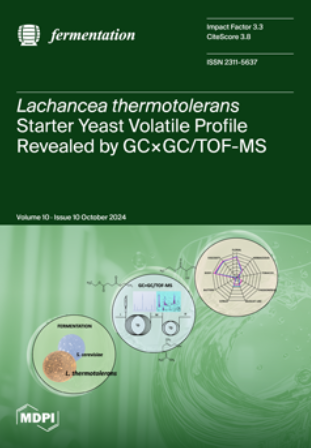Biohydrogen Gas/Acetone-Butanol-Ethanol Production from Agave Guishe Juice as a Low-Cost Growing Medium
IF 3.3
3区 农林科学
Q2 BIOTECHNOLOGY & APPLIED MICROBIOLOGY
引用次数: 0
Abstract
Different strategies have been assessed for the revalorization of guishe to obtain biomolecules. The juice obtained after the mechanical extraction of guishe is rich in phytochemicals and sugars which can be converted to other products. The objective of the present study was to evaluate the production of hydrogen and butanol at different guishe juice concentrations (and therefore, different sugar concentrations) via fermentation in batch mode using Clostridium acetobutylicum ATCC 824. Fermentation assays were performed in triplicate under anaerobic conditions at 35 °C for 142 h. Guishe juice was supplemented with all components of synthetic medium (salts, vitamins and reducing agents), except glucose, and diluted at different concentrations: 20%, 40%, 60%, 80% and 100%. For comparison purposes, a control was carried out in a synthetic medium using glucose as carbon source. Results showed a maximum butanol concentration of 5.39 g/L using 80% guishe juice, corresponding to a productivity and yield of 0.04 g/L h−1 and 0.24 g/g, respectively. Meanwhile, the highest productivity (1.16 L H2/L d−1; 1.99 mmol H2/L h−1) and yield (18.4 L/kg) of hydrogen were obtained with 40% guishe juice. This study demonstrates the potential of guishe juice to be used as a low-cost substrate for hydrogen and butanol production.龙舌兰Guishe汁作为低成本培养基生产生物氢气/丙酮-丁醇-乙醇
为了获得生物分子,已经对不同的策略进行了评估。桂舍机械提取后的果汁富含植物化学物质和糖类,可转化为其他产品。本研究的目的是评估使用丙酮丁基梭菌ATCC 824通过分批发酵在不同桂汁浓度(因此,不同糖浓度)下生产氢气和丁醇的情况。在35°C的厌氧条件下进行发酵试验,一式三份,持续142小时。桂舍汁补充了除葡萄糖外的所有合成培养基成分(盐、维生素和还原剂),并以不同浓度稀释:20%、40%、60%、80%和100%。为了进行比较,在使用葡萄糖作为碳源的合成培养基中进行对照。结果表明,使用80%的桂舍汁,丁醇的最大浓度为5.39 g/L,相应的生产率和产量分别为0.04 g/L h−1和0.24 g/L。同时,用40%的桂舍汁可获得最高的生产率(1.16 L H2/L d−1;1.99 mmol H2/L h−1)和氢气产量(18.4 L/kg)。这项研究证明了桂舍汁作为低成本底物生产氢气和丁醇的潜力。
本文章由计算机程序翻译,如有差异,请以英文原文为准。
求助全文
约1分钟内获得全文
求助全文
来源期刊

Fermentation-Basel
BIOTECHNOLOGY & APPLIED MICROBIOLOGY-
CiteScore
3.80
自引率
18.90%
发文量
594
审稿时长
7 weeks
期刊介绍:
Fermentation-Basel is an international open access journal published by MDPI, focusing on fermentation-related research, including new and emerging products, processes and technologies, such as biopharmaceuticals and biotech drugs. The journal enjoys a good reputation in the academic community and provides a high-impact forum for researchers in the field of bioengineering and applied microbiology.
 求助内容:
求助内容: 应助结果提醒方式:
应助结果提醒方式:


